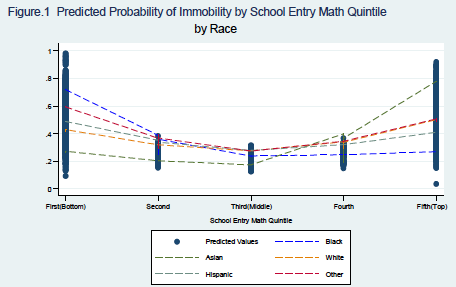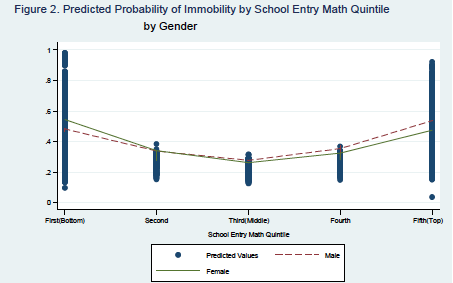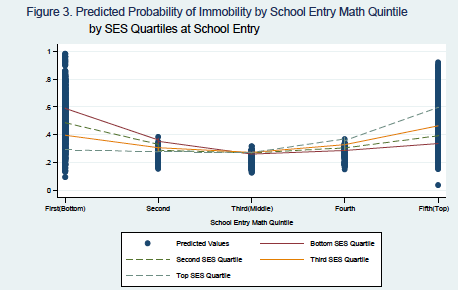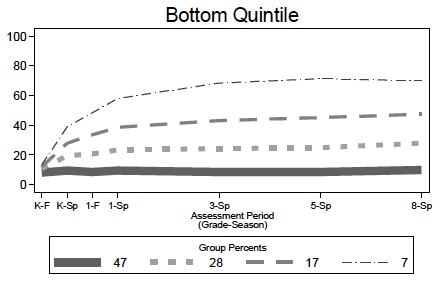Ian Peacock and Dr. Benjamin Gibbs, Sociology
The hierarchical ranking of children in schools based on cognitive skills has important implications for understanding processes of social stratification. Scholars have noted that differences in cognitive skills in the school context can reach well beyond school, influencing later occupational and economic outcomes (Kerckhoff, Haney, and Glennie 2001). Despite a large scholarship investigating cognitive skills and their link to subsequent outcomes, there is little consensus as to what extent skills developed before school entry influence future achievement and outcomes. Some scholars argue that differences at school entry are magnified over time and that advantages of children who enter school with more skills tend to cumulate, while those with fewer skills fall increasingly behind (Morgan et al. 2008; Kerckhoff and Glennie 1999). Other findings suggest, however, that pre-existing skills differences narrow during school (Leppänen et al. 2004) because disadvantaged students develop new skills at a quicker rate than their advantaged peers (Phillips et al. 2002).
We make a simple yet methodologically novel contribution to this literature to reconcile the current empirical inconsistencies. Previous studies of cognitive skill gaps have traditionally analyzed average achievement (i.e. following the accumulation of skills in linear models based on distribution means) potentially masking different effects across the distribution of student scores. Inspired by analytical models recently used for intergenerational mobility research (Bowles, Gintis and Groves 2009), we take a similar approach that allows for the mapping of non-linear relationships between skills before school entry and subsequent skills, and also allow us to examine whether or not there is a “stickiness at the ends” of the achievement distribution. That is, our methods examine whether achievement at school entry has a stronger relationship to later achievement among extreme achievers (i.e. those in the highest and lowest quintiles of achievement) than among average achievers.
To examine the extent to which skills developed before school matter for subsequent outcomes, we use the Early Childhood Longitudinal Study-Kindergarten Cohort of 1998-99 (ECLS-K). The ECLS-K is a nationally representative survey of over 20,000 children in approximately 1,000 schools beginning in kindergarten, Fall 1998. Math skills were assessed across seven waves: the beginning and end of kindergarten, the beginning and end of 1st grade, and the spring of 3rd, 5th, and 8th grade.
Given the complexity of modeling achievement over time, we analyze the data using three diverse approaches, each designed to illustrate the mobility, or the lack thereof, among the high and low achievers at school entry through 8th grade. First, we divide the distribution of math achievement at school entry and at 8th grade into quintiles. Indicator variables for membership in the 8th grade achievement quintiles are modelled in a series of logistic regressions with a number of control variables. Model-based predictions are then estimated for the probability of being in each quintile at 8th grade depending on the achievement at school entry, with controls held at their sample means. The resulting probabilities are plotted in Figure 4, which shows that students who are particularly high (i.e., highest quintile) and low (i.e., lowest quintile) achievers have a disproportionately high likelihood of being high or low achievers in 8th grade, respectively. We also find that the odds of immobility at these extremes of the distribution have a statistically significant interaction effect with race, gender, and parent socioeconomic status (Figures 1, 2, and 3)
Second, we estimate propensity score matching models—being in the middle quintile of achievement at school entry serves as the control group and being in the other four quintiles serves as alternative treatments (i.e., four different propensity score models). The outcome is the absolute difference of the percentile rank of math achievement at kindergarten entry and at 8th grade. Results indicate that, even when considering the propensity for children to be in a particular achievement quintile at school entry, being in the top and bottom quintiles is related to a lack of mobility.
Third, we estimate latent trajectory models for the top and bottom quintiles of math achievement. This analysis takes into account all of the achievement data available in the ECLS-K. The trajectories modeled are the percentile of math achievement at each time period. The model selection process resulted in four trajectories for each quintile group. Results are presented in Figure 5. The thickness of the trajectory lines are weighted by the percent of the quintile that was assigned to the group based on the maximum posterior probability rule. The thickest lines on both plots, entailing about half of all students in the quintile, is straight across showing the most likely trajectory across the school years up to high school is one of immobility.
In sum, we find that early achievement matters most at the extremes of the distribution. Interestingly, this pattern coincides with intergenerational patterns of income inequality (Bowles, Gintis, and Groves 2009), suggesting that inter- and intra-generational transmission of advantage largely operates in non-linear ways. We also find that at the extremes of the distributions different demographic groups have greater or lower odds of immobility (e.g., black children in bottom have greater odds of immobility than Asian children, similarly females in bottom have greater odds of immobility than males, and these trends are opposite at the top of the distribution). Thus, our study provides considerable evidence that extreme achievers at school entry have the greatest prospects for immobility over nearly a decade of education (roughly 50% are immobile at the extremes). Although much of the effect endures despite various controls for initial math skill at school-entry, the socioeconomic origins of are sample children is the most salient predictor of extreme achievement at school entry.






